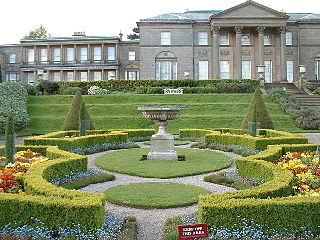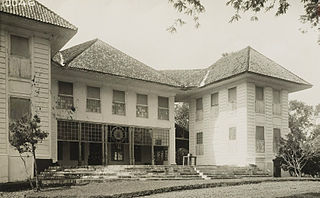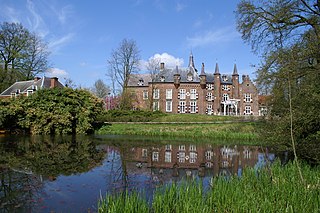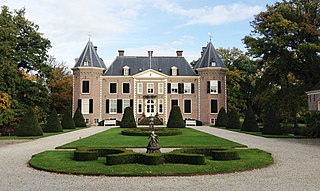
Clingendael is the name of a 17th-century manor house and surrounding parkland just outside The Hague, Netherlands, in the municipality of Wassenaar. Since 1982, it houses the Netherlands Institute of International Relations Clingendael.

Clingendael is the name of a 17th-century manor house and surrounding parkland just outside The Hague, Netherlands, in the municipality of Wassenaar. Since 1982, it houses the Netherlands Institute of International Relations Clingendael.

The name Clingendael means valley in the dunes. In 1591, Philips Doublet acquired the farm and surrounding land. The original part of the manor house was built between 1643 and 1660 for Philip Doublet III. Several of the Doublets held the office of Treasurer General in the Republic of the Seven United Provinces.
Philip's wife was the sister to the celebrated poet and statesman, Constantijn Huygens, and Philip’s son married one of Huygens’ daughters, Suzanna. The architecture of the original part of Clingendael shares some of the features of the Huygens’s country house in Voorburg, Hofwijck.
In 1804, the estate passed on to Baron Willem van Brienen. His son, Baron Arnoud van Brienen, merged Clingendael with the neighbouring estate of Oosterbeek. The two estates are separated by a meandering moat. He also built a racecourse for his guests at Clingendael; it has since been moved to nearby Duindigt. Arnout’s unmarried daughter Marguérite, known as Lady Daisy, laid out Clingendael’s fine Japanese garden.
In 1914, the manor house was renovated by the architect Johan Mutters, and was expanded in 1915 by Co Brandes and J.Th. Wouters.
During World War II, the estate was confiscated by the Nazis and occupied by Reichskommissar Arthur Seyss-Inquart. The many bunkers in the grounds of the estate date from this period.
After the war, Baron Edgar Michiels van Verduynen and his family, and Baron Johann Edzard von Ripperda and his family moved into the two estates. Both families had lost their respective, ancestral homes during the war.
In 1953, the gardens and parkland were sold to the state and, subsequently, opened up to the public. The families Michiels van Verduynen and Von Ripperda remained at the combined Clingendael-Oosterbeek estate.
Since 1982, following a thorough renovation, the manor is home the Clingendael Institute.
The Japanese Garden was created in the beginning of the 20th century by Baroness Marguérite van Brienen (1871-1939), also called Lady Daisy. Lady Daisy sailed off a number of times by ship to Japan and brought back to the Netherlands a number of lanterns, a water cask, sculptures, the pavilion, the little bridges and several plants.
The original design with the serene pond, meandering brook and the winding pathways has remained intact all these years.
The Municipality of The Hague has always taken great care of the Japanese Garden because of its uniqueness and tremendous historical value. The garden was placed on the list of national historical monuments in 2001. Due to its fragility, the garden can be visited only during a short period of the year.

The Hague is a city and municipality of the Netherlands, situated on the west coast facing the North Sea. The Hague is the country's administrative centre and its seat of government, and while the official capital of the Netherlands is Amsterdam, The Hague has been described as the country's de facto capital. The Hague is also the capital of the province of South Holland, and the city hosts both the International Court of Justice and the International Criminal Court.

Arnhem is a city and municipality situated in the eastern part of the Netherlands. It is the capital of the province of Gelderland, located on both banks of the rivers Nederrijn and Sint-Jansbeek, which was the source of the city's development. Arnhem had a population of 163,972 on 1 December 2021, which made it one of the larger cities of the Netherlands. The municipality is part of the Arnhem–Nijmegen metropolitan area, which has a combined number of 774,506 inhabitants on 31 January 2022.

Leek is a village and former municipality in Groningen province in the northeastern Netherlands. The municipality, which bordered the Drenthe and Friesland provinces, was merged into the municipality of Westerkwartier on 1 January 2019.

Wassenaar is a municipality and town located in the province of South Holland, on the western coast of the Netherlands.

Eythrope is a hamlet and country house in the parish of Waddesdon, in Buckinghamshire, England. It is located to the south east of the main village of Waddesdon. It was bought in the 1870s by a branch of the Rothschild family, and belongs to them to this day.

Petworth House in the parish of Petworth, West Sussex, England, is a late 17th-century Grade I listed country house, rebuilt in 1688 by Charles Seymour, 6th Duke of Somerset, and altered in the 1870s to the design of the architect Anthony Salvin. It contains intricate wood-carvings by Grinling Gibbons (d.1721). It is the manor house of the manor of Petworth. For centuries it was the southern home for the Percy family, Earls of Northumberland.

Penshurst is a historic village and civil parish located in a valley upon the northern slopes of the Kentish Weald, at the confluence of the River Medway and the River Eden, within the Sevenoaks district of Kent, England.

Breda is a city and municipality in the southern part of the Netherlands, located in the province of North Brabant. The name derived from brede Aa and refers to the confluence of the rivers Mark and Aa. Breda has 185,072 inhabitants on 13 September 2022 and is part of the Brabantse Stedenrij; it is the ninth largest city/municipality in the country, and the third largest in North Brabant after Eindhoven and Tilburg. It is equidistant between Rotterdam and Antwerp.

The Hague School is a group of artists who lived and worked in The Hague between 1860 and 1890. Their work was heavily influenced by the realist painters of the French Barbizon school. The painters of the Hague school generally made use of relatively somber colors, which is why the Hague School is sometimes called the Gray School.

Keukenhof, also known as the Garden of Europe, is one of the world's largest flower gardens, situated in the municipality of Lisse, in the Netherlands. According to the official website, Keukenhof Park covers an area of 32 hectares and approximately 7 million flower bulbs are planted in the gardens annually. Keukenhof is widely known for its tulips, and it also features numerous other flowers, including hyacinths, daffodils, lilies, roses, carnations and irises.

Tatton Park is a historic estate in Cheshire, England, north of the town of Knutsford. It contains a mansion, Tatton Hall, a medieval manor house, Tatton Old Hall, Tatton Park Gardens, a farm and a deer park of 2,000 acres (8.1 km2). It is a popular visitor attraction and hosts over a hundred events annually. The estate is owned by the National Trust, and managed under lease by Cheshire East Council . Since 1999, it has hosted North West England's annual Royal Horticultural Society flower show.

Benoordenhout is a neighbourhood in the Haagse Hout district of The Hague. In addition to Benoordenhout, Haagse Hout consists of the Bezuidenhout, Mariahoeve en Marlot, and Haagse Bos neighbourhoods.

Aarnoud Jan Anne Aleid, Baron van Heemstra was a Dutch nobleman, jurist and politician. He served as mayor of Arnhem between 1910 and 1920, and Governor-General of Suriname from 1921 until 1928. Van Heemstra was the grandfather of Audrey Hepburn.

Tandjong Oost, also known as Groeneveld, was a particuliere land, or private domain, in modern-day Pasar Rebo, East Jakarta, Indonesia. It was one of two estates located on the banks of the Ciliwung river: Tandjong Oost to the east of the river, and Tandjong West to the west.
Huize Ivicke is a monumental building in Wassenaar, the Netherlands. Constructed in 1913 for A. F. J. van Hattum, it is a replica of the Eremitageslottet hunting lodge in the Jaegersborg Dyrehave in Denmark. It was inhabited until the mid-1980s, when it became offices. Since 2000, it has been owned by speculator Ronnie van de Putte, known as the "Slum King of the Netherlands". He refuses to renovate the building, despite its monumental status. Heritage groups warned the local municipality in the late 2010s that the villa was severely dilapidated and it was placed on a list of the fourteen most threatened monuments in Europe. It is currently the subject of an intense dispute over emergency renovations and was squatted in 2018, by people wanting to carry out essential repairs. The house, the formal garden, the gate and the playhouse are all national monuments.

Maurick Castle is a castle in Vught, Netherlands. It had many famous owners and visitors.

Beverweerd Castle is a 13th century castle and former knight's court town, which is located on an island along the Kromme Rijn near the village of Werkhoven in the Dutch province of Utrecht. The castle is surrounded by landscaped gardens, in which the Kromme Rijn itself plays an important role in the landscape. The castle was empty for a long time and was not open to the public. Since 2006, painter and art forger Geert Jan Jansen has lived and worked at Beverweerd Castle. The surrounding gardens are ideal for walking, which offers a good view of the castle and the Kromme Rijn.

Haanwijk is an estate and nature reserve with a manor house near Sint-Michielsgestel in North-Brabant, Netherlands.

Geldrop Castle is a castle with park near the center of Geldrop, North-Brabant, the Netherlands. It is on the edge of the valley of the Kleine Dommel.

Nijenhuis is a castle and an estate near Diepenheim in the municipality Hof van Twente, Netherlands.
![]() Media related to Clingendael at Wikimedia Commons
Media related to Clingendael at Wikimedia Commons